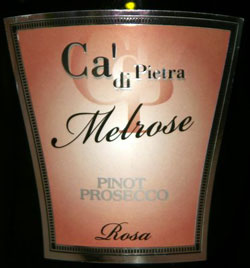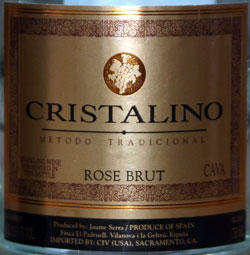Column: Arbor Vinous
Champagne price wars? Sacre bleu! What blasphemy!
But recessions produce unexpected consequences. The New York Times – while observing that “bargains are a crass notion for the industry, which carefully cultivates its image of luxury and glamour” – nonetheless reported recently that U.S. retailers are starting to discount high-end Champagne labels.
Price decay has already spread downmarket in Britain, where consumers are reaping the benefits from a glut of unsold bottles in Champagne’s massive underground caves. A full-throttle price war rages at the lower end of the market, and brand-name Champagne under $20 is the new normal.
Are we likely to see such dramatic price cuts locally? No bets – but in an early bellwether, Costco recently dropped the price on its Kirkland Champagne by $4, to $22. That nabbed it a spot in the Vinous Posse’s holiday roundup of under-$25 bubblies.
Ann Arborites who thirst for moderately-priced wines this holiday season have a great deal of company. Nationwide, the Great Recession hasn’t been kind to the wine trade’s pricier slices.
One recent California survey found that 40% of wine buyers had cut back their over-$30 wine purchases, and a like number simply stopped buying anything that costs more than $50.
Restaurants – where wine can sell for three times retail prices – took a particular wallop, as potential diners-out opt instead to eat and pull their corks at home. One recent forecast predicts wine sales in bars and restaurants will slide even further in the year to come.
Local wine-friendly restaurants Zanzibar and The Earle Uptown shuttered their doors this year, while the Detroit area lost Tribute, Morton’s and Five Lakes Grill.
These trends place high-end sparkling wines – which generate the bulk of yearly sales between Thanksgiving and New Year – squarely in the crosshairs. It requires lots of loose holiday cash to move prestige labels like Dom Perignon and Crystal that bubble up from France’s Champagne region and rely heavily on image to support their you-must-be-kidding price tags.
Even good quality $50 Champagnes – such as those Eric Arsenault recommends over at AnnArbor.com – will set you back a bundle if you plan to crack several bottles for a holiday party.
That’s why – for the second year running – we saddled up the Vinous Posse to round up some holiday-worthy alternative bubblies at moderate prices.
What’s to Drink?
It’s a dirty job – but we sampled 20 bottles of $25-and-under bubblies, procured in and around Ann Arbor. This year’s crop reflects six different countries. Some are widely available; others you’re likely to find only where we did.
(For a guide to the assortment of words and styles on and inside sparkling wine bottles, pay a quick visit to last December’s Chronicle bubbly column.)
One notable inclusion: Costco’s Kirkland Champagne – too expensive last year for the likes of us – lopped $4 off its price in 2009. It’s the first authentic French Champagne to beat our $25 cut-off.
One notable exclusion: Australia’s cheap and tacky “Bitch Bubbly” – currently being pilloried in the wine blogosphere – mercifully failed to land in Treetown by mid-November.
Also included: last year’s two top-rated wines: Gloria Ferrer Sonoma Brut and Montessel Prosecco, to see how they’d fare against a new crop of competitors.
We tasted and rated the wines on a scale from ![]()
![]()
![]()
![]()
![]() (Only mix with orange juice) to
(Only mix with orange juice) to ![]()
![]()
![]()
![]()
![]() (A tingly party on your palate). We don’t grade on the curve, which means that middle-tier wines are definitely worth your consideration.
(A tingly party on your palate). We don’t grade on the curve, which means that middle-tier wines are definitely worth your consideration.
Since sparkling wine styles vary greatly, take a look at the notes along with the ratings – they’ll help you select one to suit your taste. Unless otherwise mentioned, all have brut levels of sweetness.
Recommendations
For a delicious sparkler to remind your palate that you’re NOT sipping Champagne, look no further than CA’ DI PIETRA Pinot Prosecco, ($15 at Arbor Farms). This offbeat and decidedly off-dry rosé mingles Prosecco and Pinot Noir grapes from Italy’s Veneto region. Hands-down winner of the Posse’s coveted “Yummy!” award, it wowed experienced tasters and casual sippers alike.
Prefer something that’s more Champagne-like? Try the ROEDERER ESTATE Brut ($20 at Plum Market). Its Pinot Noir and Chardonnay grapes grew in California’s cool-climate Anderson Valley, where they were crafted into wine by the New World scion of France’s Roederer Champagne house.
For those with tight budgets – or lots of glasses to pour – we suggest CRISTALINO Cava Rosé Brut ($7, widely available) or its non-pink sibling, CRISTALINO Cava Brut, tasted last year. Both are bottle-fermented and garnered “Top Value” ratings.
Finally, area locapours may want to seek out the L. MAWBY Blanc de Blanc ($18, widely available) made from Chardonnay grapes grown on Leelanau Peninsula by northern Michigan winemaking pioneer Larry Mawby.
Something Completely Different
We sampled two wines from France’s Bugey region but didn’t include them in the ratings, because their style differs so greatly from everything else tasted.
Both ALAIN RENARDAT-FACHE Bugey-Cerdon ($25 at Everyday Wines) and PATRICK BOTTEX “La Cueille” Bugey-Cerdon ($19 at Morgan & York) are slightly sweet wines with low alcohol – in the 7% to 8% range – and massive up-front fruit flavors that originate in the Gamay grapes from which they’re made.
Traditionally, Bugey winemakers ferment wine in open cement tanks and slap them into the bottle while still fermenting – which creates the bubbles you’ll enjoy in the finished product. Think: effervescent, light-colored Beaujolais.
While these aren’t for everyone, I rated both at 4 stars, with a slight nod to the Bottex based on its darker, more mouth-filling fruit flavors. One Posse member described it as “a chorus line of frothy pink tulle.”
Which pretty much sums it up.
Ratings
=
CA’ DI PIETRA Pinot Prosecco, Italy (Arbor Farms, $15). Blast of rose petals and strawberries with easily-noticeable sweetness, guaranteed to jar awake any jaded holiday palate. Well-balanced, with nice depth and a long finish. Works better as an aperitif than with dinner. Top marks across the board from the Vinous Posse, earning its first-ever five star rating.
MONTESSEL “Vigna Del Paradiso” Prosecco Extra Dry, Italy (Village Corner, $22). One of last year’s top wines; we liked it just as much this time around. Very pale and frothy in the glass, fine bubbles and a great feel in the mouth. Slightly off-dry, with a profusion of light and bright fruit flavors, including lemon, pink grapefruit, and pear.
ROEDERER ESTATE Brut, Anderson Valley, California (Plum Market, $20). Domestic wine with a Champagne heritage and style. Granny Smith aromas and a creamy mix of toast and tart apple flavors with fine bubbles and a lingering finish. One taster called it an “apple explosion.”
CRISTALINO Cava Rosé Brut, Spain (Cost Plus, $7). TOP VALUE! Last year, the Vinous Posse gave four stars and a “Top Value” to the white version of this widely available budget bubbly; this year the Rosé yielded identical results. “Pretty in pink” – a mélange of berry flavors with some underlying tartness and long-lasting bubbles. Wine Advocate, 88 Points.
GLORIA FERRER Sonoma Brut, California (Trader Joe’s, $18). One of last year’s top two wines. Big, round apple fruit and toast flavors, with lots of fine bubbles and a long finish. Wine Spectator, 90 points.
KIRKLAND Champagne Brut, France (Costco, $22). A holiday-season staple Chez Goldberg. Shows its Champagne breeding! An apple nose, soft and easy-drinking palate with good depth, along with very fine bubbles that dissipate quickly. Wine Spectator 90 points.
PARIGOT Crémant de Bourgogne Rosé, France (Village Corner, $20). Light salmon color and a lemony palate with a slight Pinot Noir funk. “Goes well with Brie cheese,” opined one taster.
REGINATO 2007 “Celestina” Malbec Rosé, Mendoza, Argentina (Plum Market, $18). Our first Argentine bubbly. Beautiful deep pink, with ripe raspberry aromas and lots of frothy bubbles, but delivers slightly less than promised on the palate and finish. “Just a pretty face,” one taster suggested.
CHARLES DE FÈRE “Cuvée Jean-Louis”, Blanc de Blancs Brut, France (Cost Plus, $11). Light, crisp and lemony with a pleasantly round feel in the mouth. Wine Enthusiast, 87 points.
EMERI Sparkling Sauvignon Blanc, South Eastern Australia (Arbor Farms, $14). Something completely different – grapefruit and lemon zest, with hints of hay, herbs and some petrol. Certain to be controversial – it elicited a wide range of opinions among the group.
L. MAWBY Blanc de Blanc, Leelanau Peninsula, Michigan (Plum Market, $18). Slightly darker color than the name might imply; yeasty, bread-like aromas and a round palate with flavors of Granny Smith apples.
LE CHETEAU Vouvray Brut, France (Trader Joe’s, $10). Apple nose with a tart, relatively lean but pleasant palate. Lots of up-front froth that disappears quickly.
ARGYLE 2003 Brut, Willamette Valley, Oregon (Whole Foods, $25). Pretty peach and apricot nose, but a slightly oxidized and sherry-like palate. A just-bought bottle better opened a couple of years back.
FREIXENET “Cordon Negro” Cava Brut, Spain (Trader Joe’s, $10). Big lemony nose; a mouthful of bubbles leads to a simple palate with apple and lemon flavors.
OLIVINI Garda Rosé, Italy (Everyday Wines, $21). Pretty salmon color, strawberry flavors and a round mouthfeel, marred by the heavy-handed presence of burnt toast flavors. A rosé bubbly for oak lovers.
GIOL Raboso, Veneto, Italy (Whole Foods, $15). Lean red wine with black cherry and celery flavors; highly deficient in the bubble department. May have been a flawed sample, as several of the group had previously tasted better versions of this wine.
CONVENTO CAPPUCCINI 2007 Brachetto d’Aqui, Italy (Village Corner, $21) Red and sweet but slightly astringent, its simple flavor profile variously described by Posse members as “alcoholic Kool-Aid” and “Black currant Jell-O”.
POEMA Cava Brut, Spain (Plum Market, $11). Yeasty nose leads directly into earthy barnyard notes on the light, slightly acidic palate. Consistently low scores across the board.
About the author: Joel Goldberg, an Ann Arbor area resident, edits the MichWine website and tweets @MichWine. His Arbor Vinous column for The Chronicle is published on the first Saturday of the month.








“Too much of anything is bad, but too much Champagne is just right.”
–Mark Twain